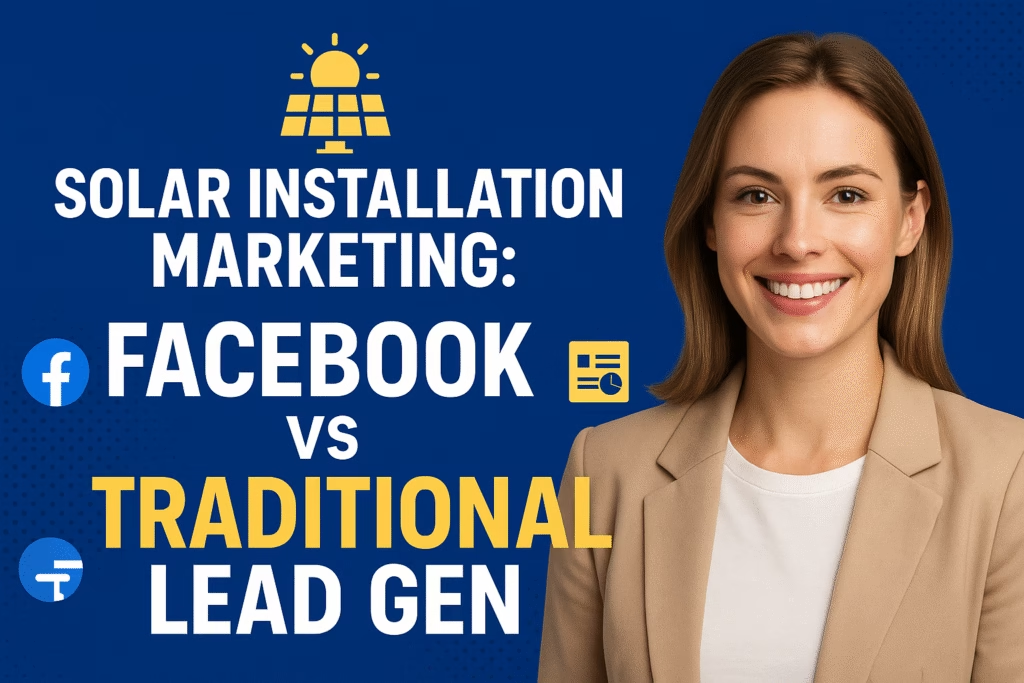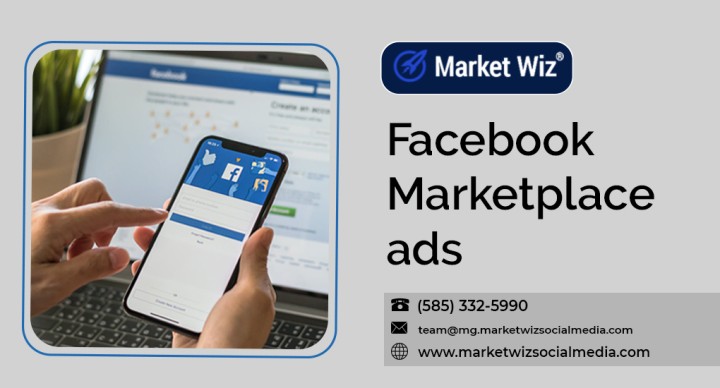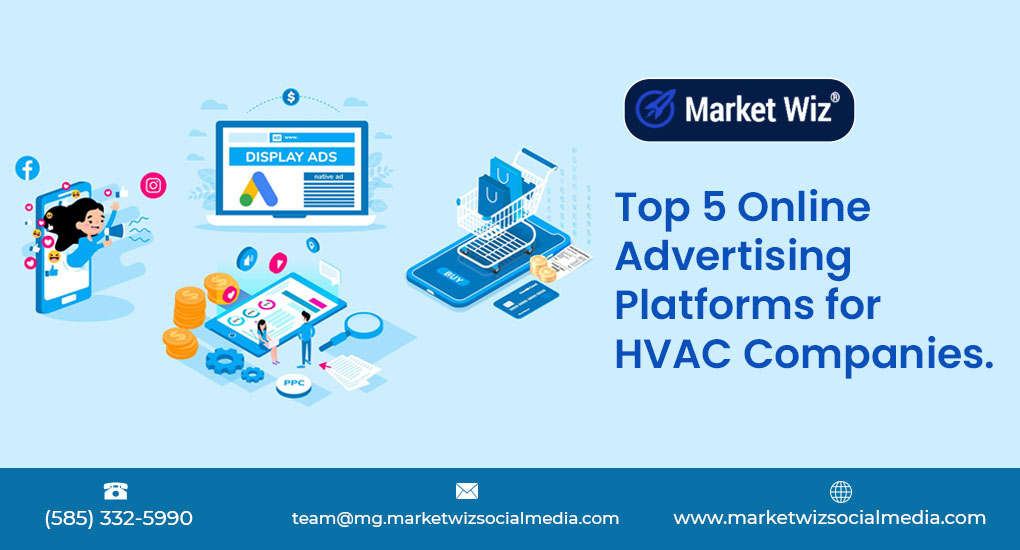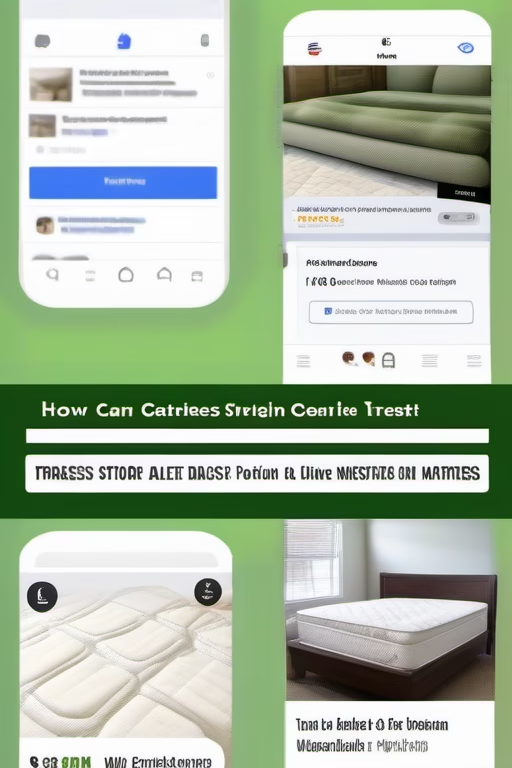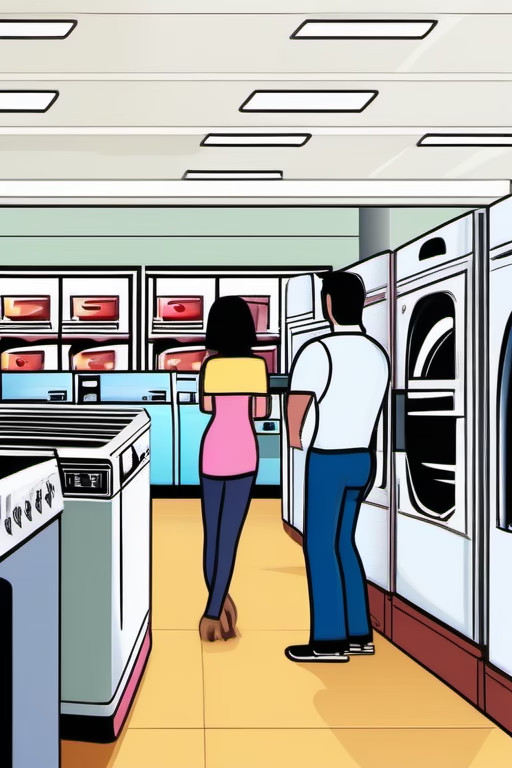Solar Installation Marketing: Facebook vs Traditional Lead Gen
Choose the right mix to turn neighborhood interest into qualified appointments—ethically and at a sustainable CAC.
Compliance: Incentives, net-metering, and financing terms vary by state and utility. Avoid blanket savings claims; disclose terms clearly and verify local rules before publishing.
Introduction
Solar Installation Marketing: Facebook vs Traditional Lead Gen pits two proven approaches: scalable, data-driven Facebook systems and neighborhood-trust traditional plays like door-to-door, mailers, radio/TV, and home shows. This guide compares channel strengths, shows what creative/offer angles actually convert, and gives you budgets, KPIs, and a 30–60–90 plan to scale appointments responsibly.
Expanded Table of Contents
- 1) Why “Solar Installation Marketing: Facebook vs Traditional Lead Gen” matters
- 2) ICPs & Targeting (Homeowner, Roof, Utility, Credit)
- 3) Channel Fit Matrix (Facebook • D2D • Mailers • Radio/TV • Events)
- 4) Facebook Lead System (Creatives • Forms • Messenger • Follow-Up)
- 5) Traditional Playbook (D2D • Mail • Home Shows • Radio/TV)
- 6) Offers & Creative Angles (Policy-Safe)
- 7) Lead Capture, Routing & Appointment Setting
- 8) Nurture & Messenger Automation (24/7)
- 9) Budget Guardrails & Media Mix
- 10) KPIs & Dashboard (From Impression to PTO)
- 11) A/B Tests That Actually Move Appointments
- 12) Website & CRO (Calc • Proof • FAQ)
- 13) Seasonality & Local Events
- 14) Compliance & Claims (Disclosures That Protect You)
- 15) 30–60–90 Day Rollout
- 16) Troubleshooting & Optimization
- 17) 25 Frequently Asked Questions
- 18) 25 Extra Keywords
1) Why this comparison matters
- Hybrid reality: Facebook scales discovery and retargeting; traditional builds local trust and referrals.
- Margin pressure: Rising CAC demands precise ICPs, clean routing, and policy-safe offers.
- Regulatory nuance: Messaging often changes by utility and state. Your process must reflect that.
2) ICPs & Targeting
Residential ICP
- Owner-occupied single-family, stable roof (age, shading), utility bill above local threshold.
- Financing-eligible (credit factors), high sun hours, NEM/PTO history in ZIP.
- Interests: home improvement, EV/backup power, local community pages.
Commercial/Light Industrial ICP
- Flat roofs or open land for ground-mount; predictable load (M-F daytime).
- Decision group includes owner/CFO/facilities; incentives may be complex.
- Channels: LinkedIn, local business councils, trade shows, targeted mail.
3) Channel Fit Matrix
| Channel | Strength | Best Use | Watchouts |
|---|---|---|---|
| Scale + targeting + remarketing | Top/mid-funnel education, lead forms, Messenger booking | Policy compliance, lead quality, fast reply needed | |
| Door-to-Door | Neighborhood trust, instant qual | Roof checks, bill reviews, event follow-ups | Training, local permits, safety |
| Direct Mail | Tangible + geo precision | High-bill ZIPs, NEM history areas | Attribution; use QR/vanity URL |
| Radio/TV | Mass reach, credibility | Brand + event pushes | Needs frequency; clear disclosures |
| Home Shows/Events | High intent, demos | Appointments on site | Booth + staffing costs |
4) Facebook Lead System
- Creatives: roof visuals, shade overlays, battery backup benefits (no sweeping claims).
- Instant Form: custom questions: roof age, utility, average bill band, homeownership.
- Messenger Flow: auto-reply within 60s; collect ZIP, bill band, roof type; book slot.
- Remarketing: landing page visitors + 30/60/90-day video viewers.
- Lead Sync: CRM with new → qualified → appointment → sold → PTO stages.
5) Traditional Playbook
- D2D: script = bill review + roof glance + appointment. Respect local rules and “no soliciting.”
- Mailers: variable data (utility name), QR to calculator, financing disclosures.
- Home Shows: live inverter + panel display, backup power demo, on-site booking.
- Radio/TV: short story + “book a roof check” CTA; mention that incentives vary.
6) Offers & Creative Angles (Policy-Safe)
Value Angles
- Backup power peace-of-mind (battery eligible homes).
- Roof-first consult (age, shading, structure).
- Utility-specific pathways (PTO steps differ).
Disclosures That Belong in Creative
- “Financing subject to credit approval; terms vary.”
- “Incentives/net-metering vary by state/utility; eligibility required.”
- “Estimates are informational, not guarantees.”
CTA ideas: “Book a Roof & Bill Review” • “Check Incentive Eligibility” • “Get a PTO Timeline”7) Lead Capture, Routing & Appointment Setting
- Capture on instant forms + site forms with 5 fields max (name, phone, email, ZIP, bill band).
- Route by ZIP/utility/roof type; prioritize qualified slots in 24–72h.
- Offer 2 time windows in confirmation SMS; send prep checklist (bill photo, roof info).
8) Nurture & Messenger Automation (24/7)
- Saved replies for eligibility, roof, incentives, PTO steps.
- Drip: Day 0, 1, 3, 7 with FAQs + case studies (no blanket savings promises).
- Re-engage no-shows with two new time options + checklist link.
9) Budget Guardrails & Media Mix
- Weighted to intent + remarketing: 50–70% Facebook (prospecting + RM), 15–30% traditional, 10–20% events.
- Target CAC ≤ 8–15% of project gross margin; reallocate to channels with higher appointment-held rates.
- Always fund speed-to-lead (replies < 5 min during open hours).
10) KPIs & Dashboard
Top
CTR • Lead rate • Cost/lead
Middle
Qualified % • Appt-set % • Appt-held %
Bottom
Close rate • CAC • Days to PTO
Quality
Compliance flags • Refund/chargeback rate • Review velocity
Benchmarks: reply < 5 min • appt-held ≥ 55–70% • close ≥ 20–35% (market dependent).
11) A/B Tests That Move Appointments
- Creative: rooftop photo vs “bill + battery” graphic.
- CTA: “Roof & Bill Review” vs “Check Incentive Eligibility.”
- Form: 3 vs 5 fields; add utility name picker.
- Messenger: 2-question vs 4-question pre-qual flow.
12) Website & CRO
- Estimator (informational only) with eligibility notes; send PDF to email.
- Local proof: installs map, testimonials, permit timelines by city.
- FAQ section addressing incentives, financing, roof, batteries, PTO steps.
13) Seasonality & Local Events
- Q1/Q2: tax-time interest + spring roof work; prioritize booking capacity.
- Heat waves & outages: backup-power messaging (battery eligibility only).
- Home shows: collect bill photos and book on site with calendar links.
14) Compliance & Claims
- Never promise universal bill elimination; use “may” and “varies by usage, system size, and utility rules.”
- Disclose financing terms, APR ranges, and credit requirements when advertised.
- Note that incentives and net-metering vary by state and utility; include links or “check eligibility.”
15) 30–60–90 Day Rollout
Days 1–30 (Foundation)
- Define ICPs by ZIP/utility; set up Facebook campaigns + remarketing.
- Publish eligibility/permit FAQ pages; add fast booking flow.
- Train SDRs on disclosures and appointment scripting.
Days 31–60 (Momentum)
- Launch mailers to high-bill ZIPs; book a home show; pair with Facebook RM.
- Produce two local case studies (with permissions); add video testimonials.
- Run 2–3 A/B tests (CTA, form, creative) and kill losers quickly.
Days 61–90 (Scale)
- Expand to adjacent ZIPs/utilities with winning creatives.
- Increase budget to channels with ≥ 60% appt-held and healthy CAC.
- Systematize compliance checks and quarterly creative refresh.
16) Troubleshooting & Optimization
| Symptom | Likely Cause | Fix |
|---|---|---|
| Many leads, low holds | Weak pre-qual or slow replies | Messenger pre-qual + reply < 5 min; offer 2 time windows |
| High cancels/no-shows | No prep checklist | Send bill/roof checklist; confirm day-of via SMS |
| Non-compliant feedback | Over-promising creative | Swap to policy-safe claims; add disclosures |
| Poor D2D yield | Targeting or script drift | Re-target blocks by bill/roof age; retrain, refine opener |
17) 25 Frequently Asked Questions
1) What is “Solar Installation Marketing: Facebook vs Traditional Lead Gen”?
A blueprint for picking and executing the right channel mix to book qualified solar appointments.
2) Is Facebook better than door-to-door?
Different purposes: Facebook scales discovery; D2D converts neighborhoods with trust. Many winners use both.
3) Do Facebook instant forms deliver quality?
Yes, with smart questions (utility, bill band, roof type) and rapid follow-up.
4) What should my first Facebook audience be?
Homeowner-heavy ZIPs with NEM history; add remarketing to site visitors and video viewers.
5) What creative works for solar?
Roof visuals, simple diagrams, backup-power stories—no blanket savings promises.
6) How fast must I reply?
Under 5 minutes during open hours. Speed-to-lead is a growth lever.
7) Which traditional channel returns best?
Depends on market. D2D + home shows perform well with strong training and booking systems.
8) Should I mail everyone?
No. Target high-bill ZIPs, owner-occupied homes, and NEM-friendly utilities.
9) What KPIs matter most?
Appt-set/held, close rate, CAC, and days to PTO.
10) Are TV/radio still useful?
Yes for brand and event pushes—pair with tracked URLs and clear disclosures.
11) How do I avoid compliance issues?
Use “may/varies,” disclose financing terms, and state that incentives depend on eligibility.
12) Can I advertise “$0 down”?
If accurate, with clear financing disclosures and eligibility terms.
13) What about batteries?
Promote backup benefits for eligible homes; avoid universal promises.
14) Should I build calculators?
Yes—informational only, with variability disclaimers.
15) What’s a healthy CAC?
Target ≤ 8–15% of project gross margin; benchmark locally.
16) How do I reduce no-shows?
Two time options, SMS reminders, and a prep checklist.
17) Are incentives guaranteed?
No. They vary by state/utility and can change—always verify.
18) How do I message outages?
Backup power peace-of-mind; clarify battery eligibility and capacity.
19) Can commercial use Facebook?
Yes—pair with LinkedIn and targeted mail to owners/CFOs.
20) Do reviews matter?
Absolutely—local proof and job photos lift conversion.
21) What if my market is saturated?
Drill into ZIPs/utility segments, refresh creative, and emphasize service/backup.
22) Should I outsource appointments?
In-house often maintains quality; if outsourcing, enforce SLAs and compliance scripts.
23) How long until results?
Facebook can spark leads immediately; sustained quality comes from testing and fast routing.
24) What’s the first asset to build?
Eligibility/permit FAQ + simple booking flow.
25) First step today?
Pick 5 ZIPs, launch one Facebook creative set with policy-safe CTA, and schedule a home show within 30 days.
18) 25 Extra Keywords
- Solar Installation Marketing: Facebook vs Traditional Lead Gen
- solar leads facebook
- solar door to door
- solar direct mail targeting
- home show solar leads
- solar backup battery marketing
- net metering messaging
- solar appointment setting
- solar eligibility checklist
- solar incentive disclosure
- solar facebook instant forms
- solar messenger automation
- solar remarketing audiences
- solar CAC benchmarks
- solar PTO timeline
- roof and bill review
- utility specific solar ads
- solar calculator disclaimer
- solar compliance claims
- solar radio tv ads
- solar lead quality
- solar case studies local
- solar incentives vary by state
- solar homeowner targeting
- solar marketing 2025 guide


